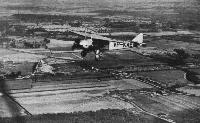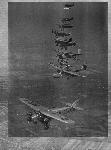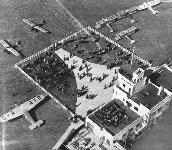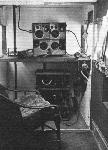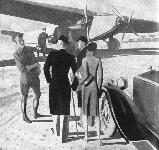
Варианты
- Fokker - F.VII / C-2 / F.XIV - 1924 - Нидерланды
- Fokker/Atlantic - F.10 / C-5 Super Trimotor - 1927 - США
- Avro - Ten / Type 618 - 1928 - Великобритания
- Avro - Five / Type 619 / Six / Type 624 - 1929 - Великобритания
Avro серий 618 Ten, 619 Five, 624 Six и 642 Eighteen
Серия 619 Five: уменьшенный вариант серии 618 Ten, рассчитанный на одного летчика и пятерых пассажиров, с силовой установкой из трех звездообразных двигателей Armstrong Siddeley Genet Major мощностью 105 л. с. (78 кВт)
Серия 624 Six: шестиместный самолет более крупный, чем серия 619, но с той же силовой установкой и двумя летчиками. По результатам летных испытаний были внесены некоторые изменения, и первые два самолета серии 624 позднее переделали в серию 619 с шестью пассажирскими местами
Описание:
- Avro серий 618 Ten, 619 Five, 624 Six и 642 Eighteen
- Flight, June 1929
BRITISH AIRCRAFT AT OLYMPIA - Flight, April 1930
AIRCRAFT FOR THE PRIVATE OWNER
Фотографии
-
Flight 1929-10 / Flight
THE AVRO V: This illustration shows the placing of the three Genet Major engines. A very wide wheel track and independently-operated wheel brakes are features of this machine, which carried four passengers in addition to the pilot.
-
Flight 1929-07 / Flight
AN ATTRACTIVE PROPOSITION: The Avro 5 is a small three-engined cabin machine fitted with Genet Major engines.
-
Aeroplane Monthly 1991-02 / J.Stroud - Wings of Peace
Регистрационный номер: VP-KAD [2] Wilson Airways Avro Five Knight Errant. The three struts beneath the wing appear to carry a pitot head.
-
Flight 1930-01 / Flight
Регистрационный номер: VP-KAD [2] A SECOND AVRO "FIVE" FOR KENYA: Our picture shows the "Knight Errant," the second Avro "Five" ordered by Wilson Airways of Nairobi, Kenya Colony. The first machine, "Knight of the Grail," was delivered by air by Capt. Campbell Black, who will shortly fly this second machine out to Kenya.
-
Flight 1929-10 / Flight
Регистрационный номер: VP-KAE [3] The Avro V sold to Wilson Airways, Ltd., and to be used in Kenya
-
Flight 1929-10 / Flight
Регистрационный номер: VP-KAE [3] THE AVRO V: This machine is not, as its registration letters might lead one to believe, the property of the Kodak Company, but of Wilson Airways, Ltd. It is here seen taking off from Heston Air Park.
-
Flight 1929-10 / Flight
Регистрационный номер: VP-KAE [3] AN AVRO V (3 GENET MAJOR ENGINES) FLYING IN THE NEIGHBOURHOOD OF HESTON: Sold to Wilson Airways, Limited, this machine is to be put into service in Kenya.
-
Flight 1934-05 / Flight
Регистрационный номер: G-ABBY [3] The staggering formation of aircraft was flown by instructors of Air Training Services Ltd in 1934. The aircraft are, from top to bottom: Avro Avian IVM, Avro Cadet, Avro Tutor, D.H.9J, Avro 626, Armstrong Whitworth Siskin III, Armstrong Whitworth Atlas, Saro Cutty Sark and an Avro Five.
Другие самолёты на фотографии: Armstrong Whitworth Atlas / Ajax - Великобритания - 1925Armstrong Whitworth Siskin - Великобритания - 1921Avro Avian / Type 594/616 - Великобритания - 1926Avro Cadet / Type 631/643 - Великобритания - 1932Avro Tutor/Sea Tutor/Prefect / Type 621/646/626 - Великобритания - 1929De Havilland D.H.9J - Великобритания - 1926Saunders-Roe Cutty Sark / A.17 - Великобритания - 1929
-
Flight 1930-07 / Flight
MEMBERS OF THE AVRO FAMILY: Beginning with the machine in the foreground, the types lined up are: The "Avian Monoplane," the "Avian" biplane, the "Avro Trainer," the Avro Five and the Avro Six.
Другие самолёты на фотографии: Avro Avian / Type 594/616 - Великобритания - 1926Avro Avian Monoplane / Type 625 - Великобритания - 1930Avro Tutor/Sea Tutor/Prefect / Type 621/646/626 - Великобритания - 1929
-
Flight 1936-12 / Flight
APPOSITE: Christmas greetings from Air Service Training Ltd. at Hamble. The message is formed by white-overalled humanity "on the hands down," and the "A.S.T." consists of the ten different aircraft types which form the organisation's fleet: Avro V, 626, Avian, Tutors and Cadets; two-seater Siskin; A.W. Atlas; two Cutty Sarks; and D.H. Leopard Moth and Hornet Moth.
Другие самолёты на фотографии: Armstrong Whitworth Atlas / Ajax - Великобритания - 1925Armstrong Whitworth Siskin - Великобритания - 1921Avro Avian / Type 594/616 - Великобритания - 1926Avro Cadet / Type 631/643 - Великобритания - 1932Avro Tutor/Sea Tutor/Prefect / Type 621/646/626 - Великобритания - 1929De Havilland Hornet Moth / D.H.87 - Великобритания - 1934De Havilland Leopard Moth / D.H.85 - Великобритания - 1933Saunders-Roe Cutty Sark / A.17 - Великобритания - 1929
-
Aeroplane Monthly 1991-02 / J.Stroud - Wings of Peace
Регистрационный номер: G-AASO [2] This view of the Avro Five G-AASO illustrates well the marriage of the Fokker wing and Avro tail unit.
-
Flight 1930-09 / Flight
Регистрационный номер: G-ABBY [3] A NEW AVRO V: In this new version of the "Five," the outboard engines have been raised and faired into the wing. The height of the cabin has been increased by about one foot. The cabin has seating accommodation for four passengers, and behind the cabin is a lavatory. The engines are Armstrong-Siddeley "Genet Majors."
-
Aeroplane Monthly 1991-02 / J.Stroud - Wings of Peace
Регистрационный номер: G-ABBY [3] Третий экземпляр Avro серии 624 Six, отличавшийся подфюзеляжными гондолами и наклонным лобовым стеклом от Avro серии 619 Five. Изображенный самолет принадлежал фирме "Air Service Training" и использовался как летающий тренажер для обучения штурманов.
The hybrid Avro Five in service with Air Service Training.
-
Flight 1930-07 / Flight
Регистрационный номер: G-AAYR [4] A NEW AVRO TYPE: The Avro Six, an experimental machine recently produced, has accommodation for two pilots, side by side, and four passengers. The headroom is greater than in the Avro Five.
-
Aeroplane Monthly 1991-02 / J.Stroud - Wings of Peace
Регистрационный номер: G-AAYR [4] The first Avro Six, with flat windscreen and high-positioned engines.
-
Flight 1931-07 / Flight
Регистрационный номер: G-AAYR [4] An Aerial view taken just as the Prince of Wales stepped out of his Puss Moth. His second machine brought one of his equerries. The Band of H.M. Grenadier Guards can be seen on the roof of the Club House.
G-AAYR - Avro Six; G-ABNN, G-ABFY, G-ABDH - D.H. Puss Moth; G-ABAD, G-AAVY - D.H. Gipsy Moth; G-ABHR - Spartan ArrowДругие самолёты на фотографии: De Havilland Gipsy Moth / Moth X - Великобритания - 1928De Havilland Puss Moth / D.H.80 - Великобритания - 1929Spartan Arrow - Великобритания - 1930
-
Flight 1929-07 / Flight
In the Avro 5 there is seating accommodation for five passengers, three in the back seat and one in each of the two arm-chair seats. The door communicates with the pilot's cockpit.
-
Flight 1934-05 / Flight
The equipment fitted in the Avro Five used by Air Service Training for wireless instruction.
-
Flight 1929-07 / Flight
Avro V 3 Armstrong Siddeley "Genet Major" Engines
- Фотографии






